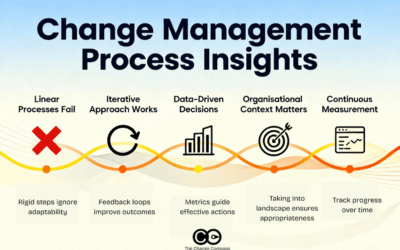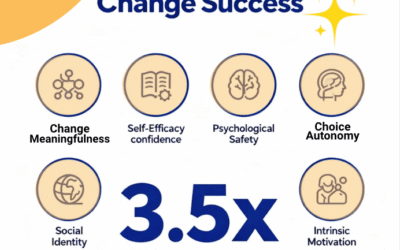There is now plenty of research and articles on successful organizational change management out there. However, most of these are focused on driving a singular change process impacting a set of key stakeholders with one change management plan. The single change may be the launch of a new product, digital transformation, a radical change that impacts the company culture, changes to internal processes, a change in the company’s strategic goals, or some kind of organizational transformation that breaks from the status quo, or examples of transformational change that lead to clear success. How many organisations can you think of that are just driving one singular change initiative across the entire organisation? Exactly.
Particularly when an organization is adopting agile ways of working, managing multiple change initiatives becomes even more critical. If everyone is working towards one big initiative launch it is much easier to plan for. It is more complex with lots of initiatives all launching a series of changes throughout the year. However, in agile organisations this is the norm. Managing the impact of changes on the frontline, in this case, becomes more complex with significant coordination and planning involved.
To effectively manage multiple change initiatives one needs to establish the following:
To manage multiple change initiatives one needs to be able to see what is changing. This sounds simple but yet one of the hardest things to accomplish for large organisations where there are often more than a hundred or hundreds of change initiatives at any one time. This is not about individual project management. To achieve this, one needs to be able to capture the data on the change impacts and how they impact different parts of the organization. This can then be used to better plan for initiatives as a part of the strategic plan.
Most organisations still struggle with spreadsheets to try and create some view of what is changing, however still not able to effectively capture the totality of what is changing since this involves a view of not just projects, but also BAU (business as usual) initiatives. To move with the times, organisations need to be able to leverage digital means of understanding what is changing, how they impact stakeholders and team members, and what this means from a planning perspective.
Effective organisational change governance and decision making
Most organisations are good at ensuring that there is a structured way of allocating the dollars to the right priorities when it comes to funding projects. However, the same may not be said for effective governance in orchestrating and planning for how change initiatives are implemented and embedded into BAU, particularly with regards to business processes. This is often not a part of the company’s culture and a part of the change management process.
An effective operations governance process is required, leveraging from a clear view of the totality of what is changing, and through this effective sequence, package, integrate or prioritise the change impacts on the organization. This includes tracking key performance indicators of the changes and ensure the entire team understands how this is tracked and reported to drive the success of change initiatives. Strong organisational leadership from the senior executives and effective communication is required to drive full adoption.
The governance body needs to be able to establish clear decision-making and escalation processes and articulate this to initiative drivers.
Oversight of Change Initiatives: Strategies for Successful Change
With significant changes happening concurrently, it is a top priority for change managers to establish clear and scalable business engagement channels as a part of the change management strategy to ensure that stakeholder groups feel like they are a part of designing the changes (vs. being a victim of them). This includes regular business forums such as weekly, monthly or quarterly meetings and standups. Other communication channels would also include intranet, email, Yammer or audio-visual outlets.
It is through well-oiled engagement channels across the entire organization that initiative owners and business leaders can quickly and frequently implement changes rapidly and concurrently. This will thereby increase the chances of success for change.
To read more about managing multiple initiatives check out our Knowledge section under Portfolio Management where we have a range of practical articles.






